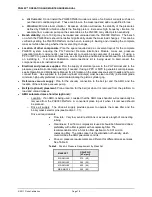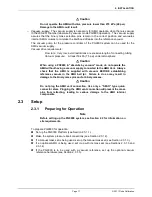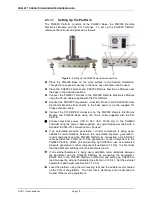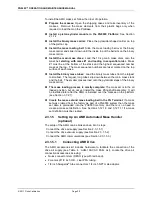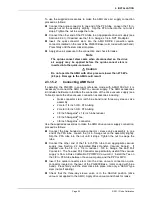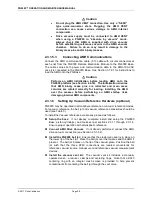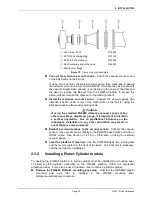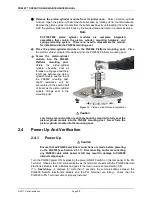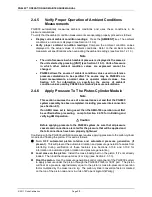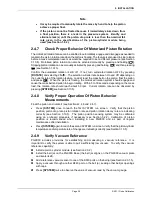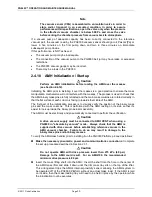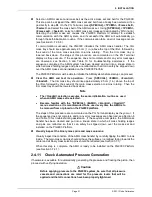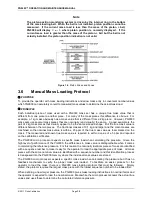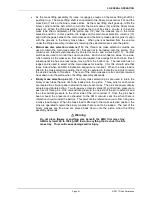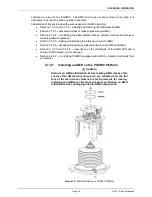
PG9602™ OPERATION AND MAINTENANCE MANUAL
© 2011 Fluke Calibration
Page
30
Note
The vacuum sensor (CDG) is assembled to an isolation valve in order to
store and/or transport in an evacuated condition. In order to assure
performance within specifications, open the valve only when the pressure
in the attached vacuum chamber is below 500 Pa and close the valve
before venting the chamber pressure from vacuum back to atmosphere.
If a vacuum pump of adequate capacity has been correctly connected to the reference
vacuum port, the vacuum read by the PG9000 vacuum sensor should go to 4 Pascal [Pa] or
lower in five minutes on the first pump down and two to three minutes on immediate
subsequent pump downs.
If this performance is NOT achieved:
•
The vacuum pump may be inadequate.
•
The connection of the vacuum pump to the PG9000 bell jar may have leaks or excessive
restrictions.
•
The PG9000 vacuum gauge may be incorrect.
•
There may be a leak in the PG9000.
2.4.10 AMH Initialization / Startup
Caution
Perform an AMH initialization before loading the AMH over the masses
(see Section 2.4.10).
Initializing the AMH prior to installing it over the masses is a good practice to ensure the mass
manipulation mechanisms will not interfere with the masses. The process is used to check that
the AMH binary mass pins are fully retracted and the main mass columns are rotated correctly in
that the flat surface of each column is facing in towards the middle of the AMH.
The first part of the initialization process is to visually verify the position of the binary mass
pins and the mass columns. This is performed with the AMH resting on it’s side so that it’s
easier to look up inside the binary pin actuator assembly.
The AMH must be electrically and pneumatically connected to perform the verification.
Caution
A drive vacuum supply must be connected to AMH VENT when using a
PG9000 in “absolute by vacuum” mode. Always check that the AMH is
supplied with drive vacuum before establishing reference vacuum in the
AMH vacuum chamber. Failure to do so may result in damage to the
binary mass pins and/or binary masses.
To verify the AMH mass handler prior to installing it on the PG9000 Platform, proceed as follows:
Make the necessary pneumatic, power and communications connections:
Complete
the set up procedure described in Section 2.3.1.
Caution
Do not operate AMH with drive pressure lower than 275 kPa (40 psi).
Damage to the AMH could result. For an AMH-100, the recommended
minimum drive pressure is 80 psi.
Insert the mass lifting shaft into the AMH: Insert the shaft into the hole in the center of
the AMH mass lifter and slide it down until the trim mass tray sits on the top of the lifter.
This arrangement trips the AMH’s internal proximity sensor allowing the AMH system to
be operated off of the PG9000 Platform without an actual mass load. If the AMH is laid
on its side, then the mass loading tray will need to be held in place by the operator while
the initialization routine executes.
Summary of Contents for PG9000 Series
Page 10: ...PG9602 OPERATION AND MAINTENANCE MANUAL 2011 Fluke Calibration Page X Notes...
Page 128: ...PG9602 OPERATION AND MAINTENANCE MANUAL 2011 Fluke Calibration Page 118 Notes...
Page 164: ...PG9602 OPERATION AND MAINTENANCE MANUAL 2011 Fluke Calibration Page 154 Notes...
Page 188: ...PG9602 OPERATION AND MAINTENANCE MANUAL 2011 Fluke Calibration Page 178 Notes...
Page 192: ...PG9602 OPERATION AND MAINTENANCE MANUAL 2011 Fluke Calibration Page 182 Notes...

